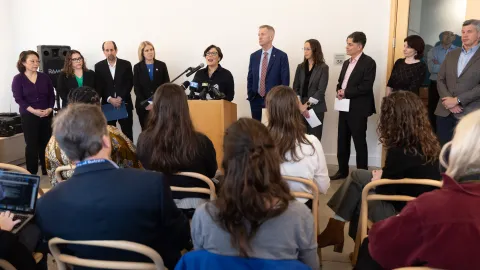About the plan
Multnomah County Chair Jessica Vega Pederson and former Portland Mayor Ted Wheeler in 2024 unveiled a strategic reset of the community’s response to homelessness, called the Homelessness Response Action Plan. Key to the plan are new metrics and other concrete steps outlining how the community can work together to house or shelter roughly 2,700 people living unsheltered over the next two years.

The Homelessness Response Action Plan:
- Is a path to provide more people with safer options off our streets that meet their needs.
- Strengthens and refocuses existing systems of care to better ensure that when someone leaves their tent or shelter bed for a home, they can remain in that home.
- Emphasizes work to address racial disparities in homelessness.
- Commits to providing expanded access to the services someone needs to leave homelessness or never have to experience it in the first place.
The plan was approved in July 2024 as part of an intergovernmental agreement creating a shared oversight structure for homelessness response between the City of Portland and Multnomah County. The intergovernmental agreement and plan were approved by both the Portland City Council and the Multnomah County Board of Commissioners in July 2024.
Read the plan
Read the full plan here:

Our progress
To track our progress on the plan, visit the Homelessness Response Action Plan Dashboard or read the latest quarterly report.
Key goals
The plan lays out short-, medium- and long-term goals. Among the top goals are:
- Sheltering or housing 2,699 people experiencing unsheltered homelessness by Dec. 31, 2025, growing the community’s existing work providing shelter and rehousing services for thousands of people a year. (This number is equivalent to 50% of the unsheltered people on the by-name list as of January 2024.)
- Adding 1,000 shelter beds in two years, and provide the resources people need to move through shelters more quickly.
- Adding hundreds more behavioral health beds and funding a drop-off sobering center.
- Increasing the number of adults leaving shelter for permanent housing by 15% by Dec. 31, 2025, and ensuring 75% of people housed in permanent supportive housing retain their housing 24 months after placement.
- Reducing homelessness among people of color, people identifying as LGBTQIA2S+ and other priority populations.
- Ending discharges to the street from behavioral health, health systems or hospitals by the end of 2025, and nding discharges to the street from corrections settings by the end of 2026.
- Ending homelessness for youth aging out of foster care in Multnomah County by 2027.
- Increasing the supply of affordable housing through regulatory changes, building conversions and new construction funding sources, among other strategies.
The plan also commits to more transparent budgeting, data sharing and financial reporting; and a new oversight structure that broadens and unifies the work of addressing homelessness and all of its root causes beyond just one downstream department, the Joint Office of Homeless Services.
The plan also formalizes collaboration between healthcare partners, the justice system, housing providers, service providers, treatment providers and government partners at all levels.
Collaborative oversight model
Key to the plan is the creation of a new oversight model. The work of the Homelessness Response Action Plan will be overseen by three committees: the Steering and Oversight Committee, the Community Advisory Committee and the Implementation Committee.
Learn more on the Committees webpage.
